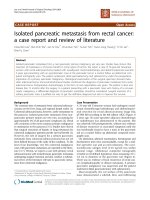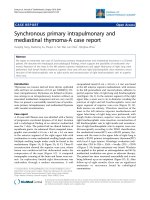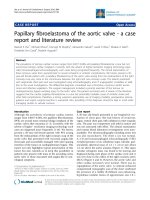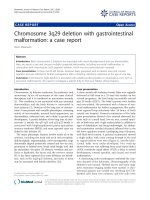Báo cáo y học: " Isolated loss of inferior pubic ramus: a case report Aly Saber" pdf
Bạn đang xem bản rút gọn của tài liệu. Xem và tải ngay bản đầy đủ của tài liệu tại đây (557.06 KB, 4 trang )
BioMed Central
Page 1 of 4
(page number not for citation purposes)
Journal of Medical Case Reports
Open Access
Case report
Isolated loss of inferior pubic ramus: a case report
Aly Saber
Address: Port Fouad General Hospital, Port Fouad, Port Said, Egypt
Email: Aly Saber -
Abstract
Introduction: It has been stated that regulation of the development of the iliac bone is different
from that of the ischium and pubis. There are well-known clinical syndromes concerned with
hypoplasia of ischiopubic bone, such as small patella syndrome, nail-patella syndrome, ischiopubic-
patellar hypoplasia, and ischiopubic hypoplasia.
Case presentation: A fit and otherwise healthy 35-year-old woman presented with pain in the
left lower limb of 6 months duration. She sought advice from an orthopedic surgeon and was
referred for exclusion of a primary soft tissue neoplasm. There was no history of trauma, chronic
medical illness or surgical operations. Full systemic examination, laboratory investigations and
whole body imaging showed no soft tissue swelling or any other bony defects. Isolated loss of the
left inferior pubic ramus and thinning of the superior pubic ramus were detected, raising the
question of whether the lesion was a secondary osteolytic lesion, a primary osteolytic lesion or due
to endocrine disease.
Conclusion: Isolated loss of the inferior pubic ramus with no concomitant bony or soft tissue
anomalies is previously unreported. To the best of the author's knowledge, this finding has not been
described previously.
Introduction
The development of the pelvic girdles has been poorly
investigated and reported evidence suggests that the regu-
lation of ilium development is different from the develop-
ment of ischium and pubis [1].
An extensive study was carried out to investigate the pre-
natal development and mineralization of ossification
centers in the pelvic bone (ilium, ischium, and pubic
bone) using radiography and optical density measure-
ments on human fetuses. The mineral density of the pelvic
bone increases with age and the mineralization rate
changes throughout fetal life [2]. The hip bone is ossified
from eight centers: three primary, one each for the ilium,
ischium, and pubis; and five secondary, one each for the
crest of the ilium, the anterior inferior spine, the tuberos-
ity of the ischium, the pubic symphysis, and one or more
for the Y-shaped piece at the bottom of the acetabulum. At
birth, the three primary centers are quite separate and by
the seventh or eighth year, the inferior rami of the pubis
and ischium are almost completely united by bone [3].
Delayed ossification of limbs and girdles is an expression
of several congenital syndromes and dysplasias, and
major morphological abnormalities can arise at any time
during the fetal period, with deformation more frequent
in the third trimester when the fetus is subjected to greater
constraint [4]. There are well-known clinical syndromes
associated with hypoplasia of ischiopubic bone, such as
Published: 12 June 2008
Journal of Medical Case Reports 2008, 2:202 doi:10.1186/1752-1947-2-202
Received: 12 September 2007
Accepted: 12 June 2008
This article is available from: />© 2008 Saber; licensee BioMed Central Ltd.
This is an Open Access article distributed under the terms of the Creative Commons Attribution License ( />),
which permits unrestricted use, distribution, and reproduction in any medium, provided the original work is properly cited.
Journal of Medical Case Reports 2008, 2:202 />Page 2 of 4
(page number not for citation purposes)
small patella syndrome, nail-patella syndrome, ischiopu-
bic-patellar hypoplasia, and ischiopubic hypoplasia [5].
Case presentation
A fit and otherwise healthy 35-year-old woman presented
with pain in the left lower limb of 6 months duration. She
had sought advice from an orthopedic surgeon and was
referred for exclusion of a primary soft tissue neoplasm.
She complained of pain in the left hip joint that worsened
with walking and long periods of standing; there was no
complaint regarding either knee. She denied any history
of trauma, violence or abnormal muscular overload.
There was no history of chronic medical illness or surgical
operations. There was no family history of congenital
defects or similar conditions.
On examination she was apparently well-built, fit and
otherwise healthy, and full systemic examination with
special attention to both breasts and thyroid showed no
soft tissue swelling or any other bony defects. There was
no evidence of any congenital anomalies especially in the
genitalia, hip bones or the long bones of the lower limbs
or chest. Laboratory investigations were performed and
showed normal organ functioning. Serum calcium and
phosphorus and a parathyroid hormone assay were car-
ried out. All were within the normal ranges.
Whole body imaging started with plain X-ray films which
showed isolated loss of the left inferior pubic ramus and
thinning of the superior, with no other bony anomalies
(Figure 1). Computed tomography scans also showed the
same findings with normal muscular attachment (Figure
2a) and a thin left superior ramus (Figure 2b). The same
findings were obtained from magnetic resonance imaging
scans. A bone scan was performed and this excluded any
osteolytic lesion, bone rarefaction, cysts or neoplasm (Fig-
ure 3).
Isolated loss of the left inferior pubic ramus and thinning
of the superior were detected, raising the question of
Plain X-ray films showing isolated loss of the left inferior pubic ramus and thinning of the superior with no other bony anomaliesFigure 1
Plain X-ray films showing isolated loss of the left infe-
rior pubic ramus and thinning of the superior with no
other bony anomalies.
Computed tomography scansFigure 2
Computed tomography scans. (a) Isolated loss of the left inferior pubic ramus and thinning of the superior with normal
muscular attachment. (b) The thin left superior ramus.
Journal of Medical Case Reports 2008, 2:202 />Page 3 of 4
(page number not for citation purposes)
whether the lesion was a secondary osteolytic lesion, a pri-
mary osteolytic lesion or due to endocrine disease.
Discussion
Review of human limb malformation syndromes revealed
a number of clinical syndromes associated with hypopla-
sia of ischiopubic bone: small patella syndrome, nail-
patella syndrome, ischiopubic-patellar hypoplasia, and
ischiopubic hypoplasia. All described pubic bone defects
as well as other bony or soft tissue anomalies [5].
Small patella syndrome (SPS) is characterized by patellar
aplasia or hypoplasia and by anomalies of the pelvis and
feet, including disrupted ossification of the ischia and
inferior pubic rami [6]. Bilateral absence of the patella in
an 11-year-old girl with absence of the ischial and inferior
pubic rami bilaterally, together with skeletal and soft-tis-
sue deformities, was reported by Habboub and Thneibat
and may represent a unique syndrome [7].
Hypoplasia of the ischiopubic region together with spinal
dysraphism and scoliosis as well as bilateral aplasia of the
patella is an extremely rare anomaly [8]. Genitopatellar
syndrome is a newly described disorder characterized by
absent and/or hypoplastic patellae, lower extremity con-
tractures, urogenital anomalies, dysmorphic features,
skeletal anomalies and agenesis of the corpus callosum
[9]. Unilateral hip dislocation in conjunction with ipsilat-
eral absence of the pubic bone, an undescended palpable
testicle and hypospadias collectively form a syndrome
that has not been reported in the orthopaedic literature
previously [10].
All of these clinical syndromes show multiple bony and
soft tissue anomalies [5-10], but in this case there was iso-
lated loss of the inferior pubic ramus without any con-
comitant bony or soft tissue anomalies. Also, there was no
association with genital anomalies. To the best of our
knowledge, a case of this type has not been described pre-
viously in the literature.
The patient presented here remained free from any com-
plaint for 35 years, a fact that reflects reported data of
patients aged from 20 to 70 years, where the main com-
plaint at consultation was with the knees due to patellar
instability and pain [11]. Many patients present early in
their lives, but a lack of significant clinical complaints was
also reported in a 77-year-old woman with nail patella
syndrome [12].
Conclusion
Hypoplasia of the ischiopubic region is described in some
syndromes together with other bony and soft tissue
anomalies. However, to the best of the author's knowl-
edge, isolated loss of the inferior pubic ramus without any
concomitant bony or soft tissue anomalies has not been
reported previously.
If the lesion in this case is congenital, it is unusual in being
isolated with no other visceral or bony manifestations.
A bone scan was performed and excluded any osteolytic lesion, bone rarefaction, cysts or neoplasmFigure 3
A bone scan was performed and excluded any osteolytic lesion, bone rarefaction, cysts or neoplasm.
Publish with BioMed Central and every
scientist can read your work free of charge
"BioMed Central will be the most significant development for
disseminating the results of biomedical research in our lifetime."
Sir Paul Nurse, Cancer Research UK
Your research papers will be:
available free of charge to the entire biomedical community
peer reviewed and published immediately upon acceptance
cited in PubMed and archived on PubMed Central
yours — you keep the copyright
Submit your manuscript here:
/>BioMedcentral
Journal of Medical Case Reports 2008, 2:202 />Page 4 of 4
(page number not for citation purposes)
Alternatively, the lesion may be secondary to an eroding
traumatic hematoma or vascular insult. The etiology of
this lesion in this patient remains unknown.
Competing interests
The author declares that they have no competing interests.
Consent
Written informed consent was obtained from the patient
for publication of this case report and accompanying
images. A copy of the written consent is available for
review by the Editor-in-Chief of this journal.
Acknowledgements
The author would like to thank Mrs Mervat Kamel for her support in pre-
paring and editing this manuscript. Also, the author would like to express
his gratefulness to his colleague Dr Amr, the patient's brother for his agree-
ment to present this report.
References
1. Malashichev Y, Borkhvardt V, Christ B, Scaal M: Differential regu-
lation of avian pelvic girdle development by the limb field
ectoderm. Anat Embryol (Berl) 2005, 210:187-197.
2. Sulisz T: Anthropometric and densitometry investigations
into the prenatal development of the human pelvic bone.
Ann Acad Med Stetin 2004, 50:139-145.
3. Bryan GJ: Skeletal Anatomy Amsterdam: Elsevier; 1996.
4. Olsen ØE, Lie RT, Lachman RS, Maartmann-Moe H, Rosendahl K:
Ossification sequence in infants who die during the perinatal
period: population-based references. Radiology 2002,
225:240-244.
5. Bongers EM, van Kampen A, van Bokhoven H, Knoers NV: Human
syndromes with congenital patellar anomalies and the
underlying gene defects. Clin Genet 2005, 68:302-319.
6. Azouz EM, Kozlowski K: Small patella syndrome: a bone dyspla-
sia to recognize and differentiate from the nail-patella syn-
drome. Pediatr Radiol 1997, 27:432-435.
7. Habboub HK, Thneibat WA: Ischio-pubic-patellar hypoplasia: is
it a new syndrome. Pediatr Radiol 1997, 27:430-431.
8. Sferopoulos NK, Tsitouridis I: Ischiopubic hypoplasia: a rare con-
stituent of congenital syndromes. Acta Orthop Belg 2003,
69:29-34.
9. Abdul-Rahman OA, La TH, Kwan A: Genitopatellar syndrome:
expanding the phenotype and excluding mutations in
LMX1B and TBX4. Am J Med Genet A 2006, 140:1567-1572.
10. Sarban S, Ozturk A, Isikan UE: Aplasia of the pubic bone in con-
junction with hip dislocation. J Pediatr Orthop B 2005, 14:266-268.
11. Beguiristáin JL, de Rada PD, Barriga A: Nail-patella syndrome:
long term evolution. J Pediatr Orthop B 2003, 12:13-16.
12. Ogden JA, Cross GL, Guidera KJ, Ganey TM: Nail patella syn-
drome. A 55-year follow-up of the original description. J Pedi-
atr Orthop B 2002, 11:333-338.









